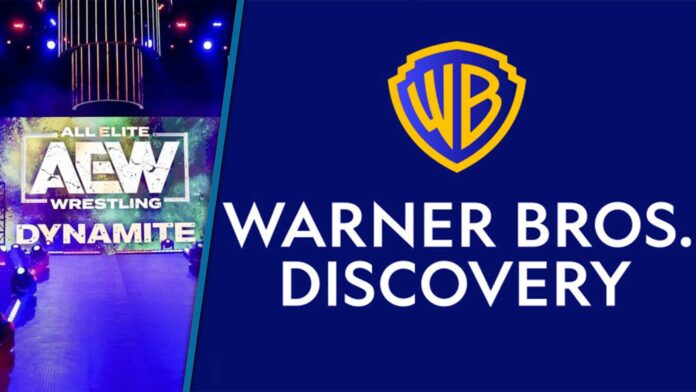
The rumor mill made the rounds with fresh speculation about All Elite Wrestling’s upcoming television negotiations, particularly because of the addition of Collision to its weekly line-up, and speculation of expanded AEW programming under the Warner Brother Discovery umbrella since the corporation completed a merger earlier this year. Reportedly, Discovery requested that the networks under the Turner banner get exclusive rights to All Elite content, which is why the more or less pointless Youtube shows were quietly concluded a few months ago. In the grand scheme of things, the request for some exclusivity doesn’t mean all that much, especially because that’s part of what Discovery is paying for with its rights fee deal, but it could provide an indication of the possible expansion of All Elite content.
The scuttlebutt online suggested that prehaps WB Discovery would look for monthly All Elite Wrestling pay-per-views to put on the newly-created Max, the former HBO Max, platform to help fuel subscribers to the streaming service.
While the initial thought for fans might be that this change would give them more PPVs at a cheaper price, the dynamics of such a move, both for the pro wrestling side and the economics of such a deal, aren’t quite that simple.
As we’ve seen with the success of Netflix the past several years, the concept of using internet technology to bring consumers bulk content at a subscription price, can be profitable if the amount of overall subscribers at the lower price exceeds the amount of revenue that could’ve been made if shows were sold individually at a higher price. It essentially took the buying in bulk concept from wholesale stores like Sam’s Club with boxes of 128 pizza rolls and 48 rolls of toilet paper, and applied it to media distribution.
The major difference is, there’s generally a fixed cost with the manufacturing of those 48 rolls of toilet paper so distributors know what they can price a bulk order at to yield a specific profit.
The media business is a much different genre, and production costs can vary depending on what type of content is being filmed. For example, a season of The Mandalorian might be more or less expensive than the previous season, depending how if the narrative of the story is set in different locations or if a production stays on schedule and budget. On the flip side, it’s much cheaper to produce a pro wrestling show because the location is usually set within one venue and it’s a live production so they aren’t multiple takes if someone botches a body slam.
The problem, which we’ve seen from the slew of streaming options that flooded the market in more recent years, is that the cost of more expensive content to produce is put on a streaming service for the same price as content that might’ve been considerably less expensive to produce. Regardless of it something took months or weeks to film, it’s more or less equal in terms of value to the audience because it’s all under the same subscription price. We saw that within the sports entertainment genre when Wrestlemania, an event that was priced at $50 to order on pay-per-view years ago, was reduced to a $4.99 value after it was included on Peacock. I understand the goal is to get many more subscribers at the cheaper price to generate more revenue overall, but the point is, the bulk pricing model does lower the perceived value of content.
That’s essentially why there was such a consolidation of streaming options more recently, and why others have struggled to stay profitable. The nature of the plarform necessitates that the amount of subscribers are maintained for a certain amount of time that it will cover the costs of productions, while there’s a batch of new content to ensure those subscriptions continue each month. The biggest pitfall, something that was seen across the board among the streaming landscape, is that customers have the option to cherry pick the content they want to watch so they only subscribe during certain months, which brings an uncertain amount of revenue over a specific period of time. Similar to the traditional movie industry, if a film flops, there are massive losses for studios, and there are undoubtedly mega losses for streaming platforms if it can’t maintain its subscriber base.
The best current example of this is entertainment powerhouse Disney, which lost such a staggering amount of money on its Disney+ streaming platform over the past few years that former CEO Bob Chapek was given his walking papers in November of last year in favor of the previous CEO, Bob Iger, who retired from the role a few years prior. Iger, who agreed to return in the executive spot for two years to help find his next successor, made headlines just days ago when he announced that the media conglomerate that owns several networks would consider selling some of its media properties. Many analysts cited that the nearly $800 million loss and a loss of four million Disney+ subscribers in the third quarter prompted some sale discussions. The ripple effect saw the firing of many of the longest-tenured hosts at ESPN, a network Disney owns, just a few weeks ago to cut costs of its more expensive contracts.
Perhaps, the corporation bought too many media properties too quickly at higher price than the revenue that can be generated from them, but the point being, if Disney is losing hundreds of millions of dollars on streaming services then it’s undoubtedly a cautionary tale for any other company that wants to invest into streaming platforms.
As mentioned, the Warner Brothers Discovery merger brought more content to the Max service, which is why the HBO portion was dropped, as the simple title actually represented that more content from the Discovery side was added. Of course, the foundation of the platform is the legacy content from HBO with shows like The Sopranos, The Wire, Boardwalk Empire, and other series being included in their entirety. While subscribers to the HBO channels through their cable provider get access to Max included, the ability for Max to be its own service allows for customers to subscribe to the platform, even if they don’t subscribe to the HBO channels.
When HBO discontinued its boxing series in 2018 after the sport was a pillar on the channel for years, a void was left around HBO Sports, which only has its occasional “Real Sports” talk sport and the “Hard Knocks” NFL documentary series for about six weeks before each season as its sports properties. The economics of the boxing business, which was more or less ruined by the political red tape of the sport, made it unprofitable for the network to maintain its boxing contract. So, after four decades and some of the most historic fights in boxing history, HBO concluded its association with the sport.
However, this is where All Elite Wrestling might be used to fill the streaming sports void for WB Discovery.
Professional wrestling actually has a history on HBO, as Madison Square Garden cards, the premiere events of the era, were aired on the channel throughout the 1970s. The biggest wrestling shows were one of selling points for the network after it originally launched. If All Elite Wrestling can be an answer for Max more than fifty years later is a different discussion. Quite simply, AEW usually runs four main pay-per-views a year that costs $50 for fans to order. The current price of a Max subscription is $9.99, and the typical AEW buyrate is around 140,000 buys. After there’s the usual split with distributors, AEW nets a specific profit for each pay-per-view. Basically, WB Discovery would have to offer the company enough cash that it would make economic sense for them to take the guaranteed money instead of selling individual pay-per-views over the course of the year. Granted, it would also have to be a number that would make sense for Discovery as well, as far as the AEW content would have to generate a specific amount of subscribers and revenue for there to be a profit for them.
If that number is realistic and the potential for sustained profit is realistic remains to be seen, but All Elite Wrestling on the Max platform would definitely serve a purpose for Discovery. First and most importantly, AEW has a core fan base that is willing to spend money on the product so there’s a market for premium All Elite content. Almost just as important is that AEW on Max for pay-per-views would give the platform continuous content, which gives fans a reason to continue to subscribe to the service and thus ensures revenue for Discovery.
If the numbers would make sense is still a question mark, and there’s no guarantee for success. Keep in mind, the WWE Network usually averaged about 1.5 million subscribers, depending on if one of the major pay-per-views were on the schedule. The network seemed to be okay as a business venture, but wasn’t the major success that many initially expected. The majority of the WWE TV audience didn’t want to pay for more programming. If the Network was a major success then the company wouldn’t have signed a rights deal with Peacock.
All Elite Wrestling has five hours of weekly programming on television, is there really a demand for more of the product, especially given the declining Collision ratings? Furthermore, given Tony Khan’s E-fed style of booking with random gimmick matches on television, would the pressure of monthly pay-per-view cards add to the quality of the promotion?
The diehard AEW fans might scoff at this, but I actually don’t think monthly pay-per-views would benefit the product. Remember, monthly pay-per-views only became a staple of the industry during the competition of WWF and WCW in the 90s. Since that time, there hasn’t necessarily been a scenario where there was the demand for monthly PPVs, and truthfully, one of the more refreshing aspects of the AEW product is that the quarterly shows are what allow each pay-per-view to be a special event. There seems to be way too many potential pitfalls, both for Discovery from an economic standpoint if they offer guaranteed money for monthly pay-per-views, and for AEW there’s the risk of oversaturating the market. With the exception of the most diehard fans, people are only going to watch a certain amount of pro wrestling content, and if a certain monthly pay-per-view seems to have a lackluster line-up then the event isn’t a “must see” show.
However, the biggest potential pitfall is that once AEW puts pay-per-views on a streaming service for $9.99, it would be very difficult to try to sell them for the traditional $50 price tag at any point in the future. Again, the bulk business model unintentionally lowers the value of individual commodities. Right now, those $50 pay-per-view events with the steady 140,000 buyrate are a part of one of the company’s most profitable revenue streams so there seems to be no reason to put that in jeopardy with a streaming deal.
What do you think? Share your thoughts, opinions, feedback, and anything else that was raised on Twitter @PWMania and Facebook.com/PWMania.
Until next week
-Jim LaMotta
E mail [email protected] | You can follow me on Instagram, Facebook, & Threads @jimlamotta89







